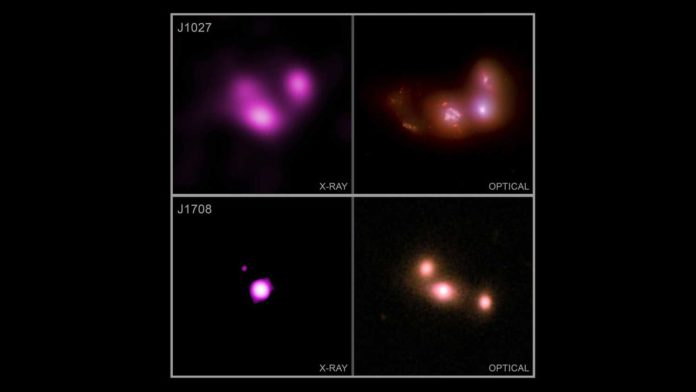Studying galactic collisions is essential to understand how subsequent mergers are vital so that galaxies and the giant black holes in their cores grow over cosmic time.
Several studies have shed light on what happens to supermassive black holes when two galaxies merge. A new study has discovered what happens to the huge black holes after the collision of three galaxies.
The study used data from NASA’s Chandra X-ray Observatory and several other telescopes to uncover new information about how many black holes are furiously growing after these galactic smash-ups.
This is the first study that systematically looks at black holes when three galaxies come together.
By cross-matching the archives of NASA’s WISE mission and the Sloan Digital Sky Survey (SDSS) to the Chandra archive, astronomers could identify triple galaxy merger systems. This method discovered seven triple galaxy mergers located between 370 million and one billion light-years from Earth.
Later on, a specialized software developed by Adi Foord (Stanford University) was used to determine X-ray sources marking the location of growing supermassive black holes. As material falls toward a black hole, it gets heated to millions of degrees and produces X-rays.
Chandra, with its sharp X-ray vision, is ideal for detecting growing supermassive black holes in mergers. The associated X-ray sources are challenging to see because they are usually close together in images and are often faint. Foord’s software was developed specifically to find such sources. Data from other telescopes were then used to rule out different possible origins of the X-ray emission unrelated to supermassive black holes.
Foord and the team’s results show that out of seven triple galaxy mergers, there is one with a single growing supermassive black hole, four with double growing supermassive black holes, and a triple.
The final triple merger they studied seems to have struck out with no X-ray emission detected from the supermassive black holes. The separations between them range between about 10,000 and 30,000 light-years in the systems with multiple black holes.
Co-author Jessie Runnoe of Vanderbilt University in Nashville, Tenn, said, “Why do we care about the hitting percentage of these black holes? Because these statistics can tell us more about how black holes and the galaxies they inhabit grow.”
After finding evidence for bright X-ray sources as candidates for growing supermassive black holes in the Chandra data, astronomers incorporated archival data from other telescopes. These data backed up the idea that multiple black holes were present in the merged galaxies.
To make these calls, the authors studied infrared data from the WISE mission, the Infrared Astronomical Satellite, and the Two Micron All Sky Telescope to see how quickly stars are forming in the different galaxies in their survey. This allowed them to estimate how many detected X-rays are likely to come from X-ray emitting systems containing massive stars rather than a growing supermassive black hole. Because such star systems are young, they are more common when stars are forming more quickly. Foord and her colleagues used this technique to conclude that one of the X-ray sources they found is likely from a collection of X-ray emitting star systems.
The Chandra and WISE data show that the system with growing supermassive black holes has the largest amount of dust and gas. This matches theoretical computer simulations of mergers that suggest higher levels of gas near black holes are more likely to trigger the black holes’ rapid growth.
Co-author Michael Koss of Eureka Scientific in Oakland, California, said, “There is a “nightmare scenario” where supermassive black holes cannot lose enough energy to come close together and make gravitational waves. If this is the case, then projects like LISA and pulsar timing arrays won’t have any supermassive black hole mergers to detect.”
Journal References:
- Adi Foord et al. AGN Triality of Triple Mergers: Detection of Faint X-ray Point Sources. arXiv:2012.00761
- Adi Foord et al. AGN Triality of Triple Mergers: Multi-wavelength Classifications. arXiv:2012.00769
